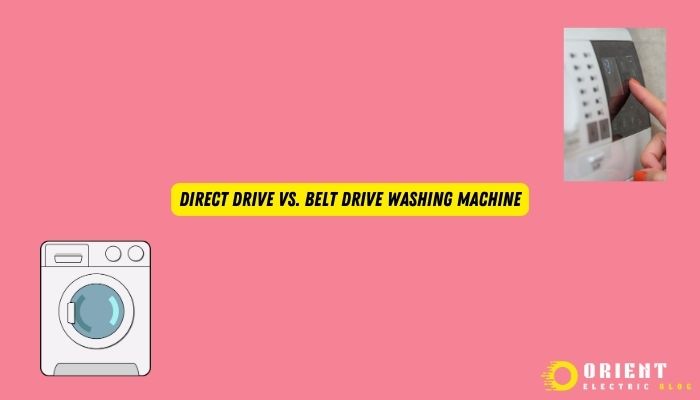We virtually always use washing machines, which are essential pieces of home equipment. There are now two types of washing machines on the market: belt drives and direct drives, thanks to technological improvements. Before choosing between a direct drive vs belt drive washing machine, it’s critical to comprehend their differences.
Understanding how Direct Drive and Belt Drive washing machines differ from one another might help you select the best washing machine for your requirements.
Direct Drive vs Belt Drive Washing Machine
This blog will examine the distinctions between Direct Drive and Belt Drive technology and their benefits and drawbacks. But before we get started, let’s define Direct Drive and Belt Drive washing machines and discuss why this subject is crucial.

What is a Direct Drive Washing Machine?
As the name implies, a direct drive washing machine has no pulleys, belts, or gears and a motor hooked directly to the drum. The speed and direction of the drum are controlled by the motor, which is controlled by a microcontroller.
Direct drive technology has several advantages compared to washing machines with belt drives.
- First, it does away with the requirement for belts, which are prone to wear and tear and can eventually fail, requiring expensive repairs.
- Second, noise and vibration are reduced since no belts or pulleys are grinding against one another.
- Last but not least, thanks to the sophisticated control systems that govern the motor’s speed, Direct Drive washing machines are more energy-efficient because they consume less water and power.
Since no belts or pulleys need routine maintenance or replacement, direct-drive washing machines are also simpler to maintain. However, because of their sophisticated technology, they sometimes cost more than washing machines with belt drives.
However, Direct Drive washing machines provide a better washing experience and are more robust than Belt Drive washing machines.
What is a Belt Drive Washing Machine?
A belt connects the engine and drum in a classic washing machine known as a belt drive. The motor rotates the drum through a belt, and the gearbox or transmission controls the drum rotation speed.
Until recently, most washing machines employed belt drive technology, which has been around for a while. This technology does, however, have significant shortcomings.
- First, belts frequently need to be repaired because of wear and tear.
- Second, belts can slip or strain, causing the drum to wobble, making Belt Drive washing machines noisier and more vibrational than Direct Drive washing machines.
- Finally, due to less sophisticated control systems that regulate the motor’s speed, Belt Drive washing machines tend to be less energy-efficient than Direct Drive washing machines. This is because they use more electricity and water.
In contrast to Direct Drive washing machines, Belt Drive washing machines are typically less expensive, making them a popular option for people on a budget.
As the belts are simple to replace, they are also generally accessible and simple to fix. They are less long-lasting than Direct Drive washing machines, though, as the belts deteriorate more quickly and must be replaced more frequently.
Comparison of Belt Drive And Direct Drive:
Now that we’ve discussed their technological foundations let’s compare Direct Drive and Belt Drive washing machines.
- Energy efficiency: Belt Drive washing machines use more electricity and water, but Direct Drive washing machines use less. Advanced control mechanisms that manage the motor’s speed make sure that each load only uses the right quantity of water and electricity.
- Noise level: Washing machines with Direct Drive are quieter and shake less than those with Belt Drive. This is so that no noise or vibration is produced by belts or pulleys rubbing against one another.
- Maintenance requirements: Direct Drive washing machines require less maintenance than Belt Drive washing machines because no belts or pulleys need to be replaced or adjusted regularly. However, repairs may be more expensive if the motor or the control systems malfunction.
- Durability: Because fewer parts could wear out or break, Direct Drive washing machines are more durable than Belt Drive washing machines. Direct Drive washing machines are less likely to sustain usage or wear and tear damage.
- Cost: Due to their advanced technology, Direct Drive washing machines are often more expensive than Belt Drive washing machines. However, the longer-term reductions in electricity and water expenses frequently outweigh the added expense.
In general, Direct Drive washing machines outperform Belt Drive washing machines in terms of performance, energy efficiency, and longevity. However, they also cost more money. Ultimately, the selected option relies on personal preferences, needs, and financial constraints.
Conclusion:
In conclusion, choosing the correct washing machine requires understanding the differences between Direct Drive vs Belt Drive Washing Machines. Direct Drive washing machines are more durable, energy-efficient, quieter, and easier to maintain than Belt Drive ones. Belt Drive washing machines are cheaper and more widely available, making them a fantastic budget option.
Direct Drive or Belt Drive washing machines depend on personal preferences. Choose based on affordability, energy efficiency, noise, maintenance, and durability.
This Direct Drive and Belt Drive washing machine page might be helpful. Please provide comments about these technologies.
